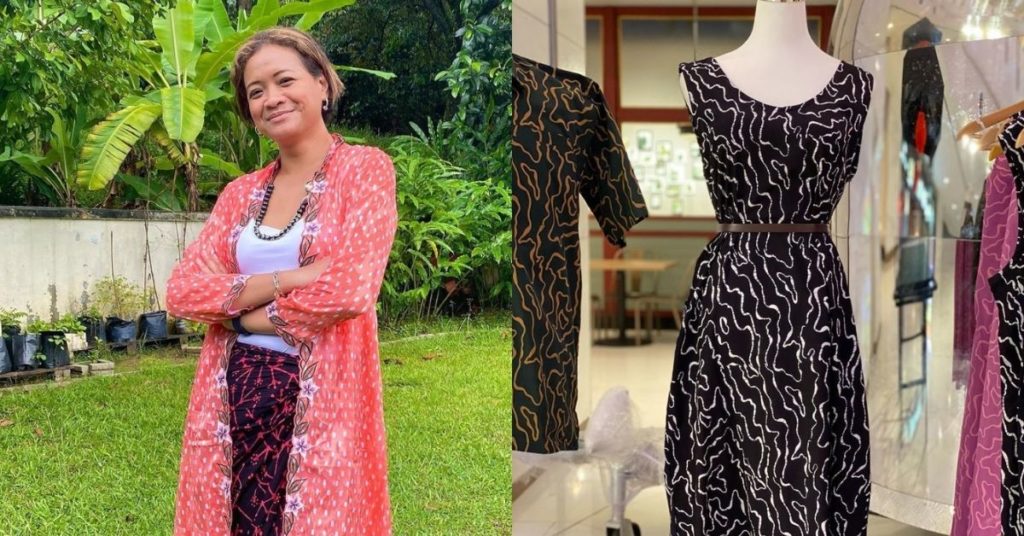We’ve spoken to many entrepreneurs with side hustles who eventually leave their full-time jobs to wholly focus on their businesses. This tends to be the case once the business has gained traction, but the same can’t be said for Yez, an architect who’s one-half of the founding partners of batikTEKTURA, which started in 2018.
“batikTEKTURA and architecture can never be separated, as the main inspiration for the batik designs are very much anchored to her day-to-day work in architecture,” Azrina, the other half of the brand told Vulcan Post.
“To stay up-to-date with current trends in architecture, she needs to be in the industry. We also see the synergy between the two sectors as we can tap into our architecture clients for batik interior designs.”

What makes batikTEKTURA stand out from the myriad of batik fashion brands in the market, is its contemporary designs that take inspiration from architectural motifs.
The brand’s preferred design aesthetics are in clean, modern lines, which the team marries with the art of traditional batik making.
Inspired by concrete jungles
batikTEKTURA’s design motifs are based on a strong understanding of architectural concepts, elements, and principles. Instead of applying them in a building design, the team applies them to fabrics.
But to me, traditional batik patterns are typically inspired by nature. So I was curious to understand how Yez and Azrina defined “batik” in their own terms.
The long-term high school friends argued that batik is more characterised by the technique used to make the prints on the fabric, not so much the patterns themselves.
“Having said that, you can still feel a Malaysian vibe in [our] designs as the motifs we picked are inspired by the Malaysian natural, or built, environment,” Yez and Azrina added.
This can be seen in one of their batik collections from 2020, titled Liku.
It’s based on the idea of contours as an element in landscapes, where buildings are sometimes built on terrains. To make Liku special to batikTEKTURA, they referred to the contours of Bukit Larut in Taiping, where the duo’s boarding school was.

In 2022, batikTEKTURA created Fraktal, based on the fractal mathematical concept which can be found in tree branches and snowflakes.
“The never-ending and scaling characteristics of fractal geometry are aesthetically pleasing and many building designs have been inspired by this concept,” they shared.

Merging modern and traditional
batikTEKTURA’s prints are still made the traditional way: handblocked, using wax-resist dyeing (a technique using hot wax to create the design on the fabric, then applying dyes).
“We had tried digitally-printed batik but we felt we were not doing justice to the craftsmanship,” the co-founders shared. “Making batik the traditional way also gives it an edgier look (e.g. more imperfections, so no two pieces are alike) and this is how we want our brand to be represented.”
Working with small batik makers in Kuala Terengganu, batikTEKTURA helps these communities continuously make a living while preserving the art of handmade batik.

However, Yez and Axrina told Vulcan Post it wasn’t easy getting the batik makers on board, mainly because of their contemporary designs.
“At the beginning, many turned us down,” they recalled. “We finally found a workshop that was willing to give it a try. Once they [saw] the final outcome of our designs, they were excited to work with us from then on.”
“We were especially thrilled when our batik maker was willing to partner with us when we entered as a team during the Piala Seri Endon in 2019.”
The event was part of an annual batik design competition in Malaysia and batikTEKTURA was recognised for the submission entitled “Lines.Voids.Solids”.

Despite being a rookie in the competition, batikTEKTURA won third place in the Soft Furnishing Category.
Yez and Azrina believe this milestone strengthened their relationships with the batik makers. They could be seen as capable of producing good designs that the public appreciated.
Threading the business
Because batikTEKTURA’s products are handmade and take up to a week to complete, the quantities per batch are limited with up to 500 of each design made, depending on demand.

Nonetheless, Yez and Azrina hope to scale up production as they gain a better understanding of the market’s demands for their garments.
To do so, they plan to recruit talents in fashion design, tailoring, and crafting. This will go alongside their other expansion plans which include having a retail-cum-office outlet in KL, and a studio in Kuala Terengganu for batik R&D work.
- Learn more about batikTEKTURA here.
- Read other articles we’ve written about Malaysian startups here.
Featured Image Credit: batikTEKTURA
